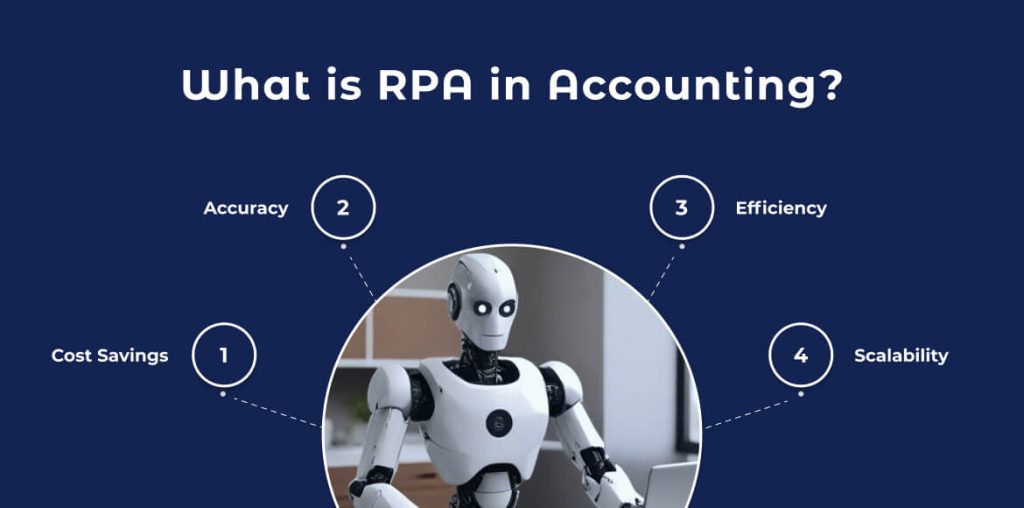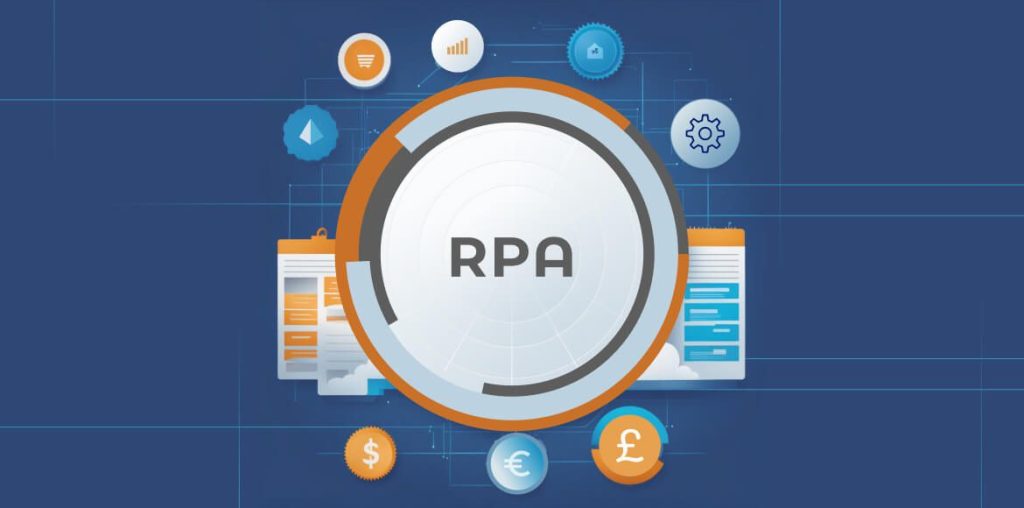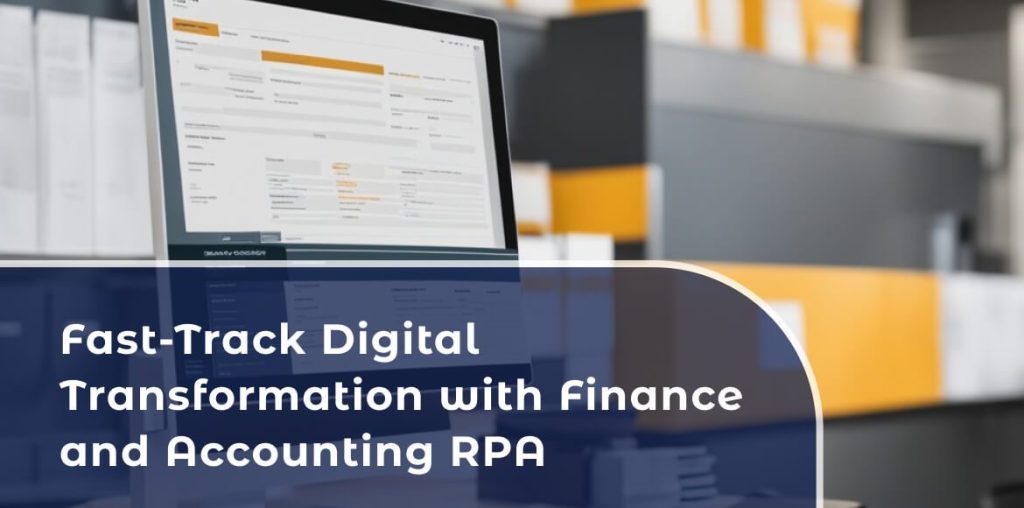Robotic Process Automation (RPA) represents a significant shift in how accounting and finance departments operate, bringing unparalleled efficiency and accuracy to routine processes. This guide delves deep into the essence, necessity, and benefits of RPA in accounting, backed by practical use cases and insights on navigating the digital transformation it entails.
What is RPA in Accounting?
The transition to robotic accounting unfolds a suite of advantages for organizations, notably:
- Cost Savings: The shift from manual to automated processes courtesy of RPA spells significant reductions in the overhead costs associated with manual tasks, translating to direct cost savings for the business.
- Accuracy: Given the rule-based nature of RPA, financial statements and reports are generated with a high degree of precision, mitigating the risk of errors that could stem from manual data entry or processing.
- Efficiency: RPA's ability to swiftly process transactions and data leads to an enhanced operational efficiency, notably in accounts payable and receivable, financial reporting, and other critical accounting tasks.
- Scalability: As businesses grow, so do their transaction volumes and financial activities. RPA's scalability means that accounting departments can handle increased workloads without the proportional need for additional staff, facilitating growth without equivalent rises in operational costs.

Why do Enterprises Need Accounting Automation with RPA?
Enterprises require RPA in accounting to streamline operations, ensuring tasks that are essential yet redundant are managed more efficiently. This technology minimizes the reliance on manual labor for data entry and invoice processing, areas prone to error and requiring significant man-hours. By automating these processes, RPA significantly reduces operational costs and reallocates human capital towards more analytical and value-added activities.
Furthermore, the accuracy brought about by RPA in financial reporting and regulatory compliance tasks is invaluable. It mitigates risks associated with manual errors and inconsistencies, ensuring that enterprises remain compliant with financial regulations without the exhaustive manual oversight traditionally required. This shift not only optimizes resource use but also enhances the reliability of financial data, which is critical for informed decision-making and maintaining stakeholder trust.
What Are The Key Benefits of Robotic Accounting?
Robotic accounting transforms the financial landscape of enterprises by introducing a suite of benefits centered around efficiency, accuracy, and strategic resource allocation. One of the most significant advantages is the reduction of operational costs. By automating routine tasks such as accounts payable and receivable, invoice processing, and financial statement preparation, RPA reduces the need for extensive manual labor, thereby lowering payroll expenses and associated costs.
Additionally, RPA enhances the accuracy of financial operations. Automated systems are designed to follow precise rules without deviation, virtually eliminating errors in data entry, financial reporting, and regulatory compliance documents. This level of precision is crucial for businesses that rely on accurate financial data to make strategic decisions and maintain compliance with ever-changing financial regulations.
Another key benefit is the improvement in time efficiency. RPA can process transactions and data at a speed no human team can match, significantly shortening the financial close cycle and enabling real-time reporting. This rapid processing capability allows finance teams to provide timely insights into the financial health of the enterprise, supporting agile decision-making and strategic planning.
The implementation of RPA in accounting processes invariably leads to better employee satisfaction. By automating mundane and repetitive tasks, staff can focus on more engaging and impactful work, leading to higher job satisfaction and retention rates. This shift not only benefits the employees but also the organization as a whole, as it cultivates a more motivated and efficient workforce dedicated to driving the company forward.
The Advantages of Using RPA
Delving deeper into RPA benefits:
- Time Efficiency: Automate accounting processes such as invoice processing and data extraction, significantly cutting down on processing time.
- Regulatory Compliance: Maintains compliance with financial regulations through precise and consistent data input and record-keeping.
- Customer Satisfaction: Indirectly improves customer service by speeding up response times and financial planning accuracy.
How is RPA Used in Finance and Accounting?
In the finance and accounting sectors, RPA has catalyzed profound operational transformations. Specifically, automating accounts receivable/payable has expedited invoice and payment processing, reducing transaction times from days to mere hours. This showcases RPA's ability to enhance operational efficiency significantly.
In addition, RPA has transformed the financial close process, turning a traditionally labor-intensive and error-prone task into a streamlined and reliable process. Additionally, the integration of AI and machine learning technologies within RPA platforms has extended these benefits, allowing for even complex financial analyses and predictions to be automated with high precision.
Organizations using RPA in these areas have seen cost reductions of up to 40%, as well as significant improvements in compliance and reporting accuracy, according to studies and reports from industry leaders such as Gartner and Deloitte.
As RPA technologies continue to evolve, they are expected to offer even greater efficiencies, with predictive analytics and enhanced decision-making capabilities at the forefront of future trends. This evolution highlights the crucial role of RPA in automating tasks and reshaping strategic financial planning and analysis.
What are the Use Cases of RPA in Accounting?
Key use cases include:
- Accounts Receivable and Payable: Automating invoice matching and payments processing.
- Financial Close: Facilitating a faster and more accurate monthly close by automating data entry and reconciliation tasks.
- Regulatory Reporting: Ensuring compliance through automated data collection and report generation.

Fast-Track Digital Transformation with Finance and Accounting RPA
RPA enables finance departments to embrace digital transformation swiftly, bridging gaps in financial process automation and turning bottlenecks into breakthroughs. By adopting RPA, companies can automate end-to-end, transforming their finance and accounting departments into hubs of innovation and efficiency.
Mind Your Gaps in Financial Process Automation
RPA addresses automation gaps in quote-to-cash, procure-to-pay, and record-to-report processes, enhancing data management and reducing the workload on finance teams.
Invoice Processing for Accounts Payable
One of the standout benefits of RPA is its ability to dramatically cut invoice processing time, turning a traditionally labor-intensive process into a swift, automated operation.

Regulatory Compliance
In the realm of Regulatory Compliance, automation tools are pivotal in navigating the complex tapestry of financial regulations with unparalleled precision and efficiency. These advanced systems meticulously manage and monitor compliance requirements in real-time, significantly reducing the risk of costly violations. By automating compliance workflows, companies ensure that every financial transaction and report adheres to the latest regulatory standards without the need for extensive manual oversight.
A study by the Aberdeen Group highlights that automation can lead to a remarkable 66% reduction in transaction errors, a direct contributor to enhanced compliance rates. Furthermore, the deployment of BPA in compliance processes has been shown to reduce related costs by up to 45%, according to recent IBM findings. This not only showcases the direct financial benefits of embracing automation for regulatory purposes but also underscores the strategic advantage it provides in maintaining a company's integrity and reputation in highly regulated industries.
This enhancement integrates specific benefits and statistics into the Regulatory Compliance section, offering a data-driven perspective on the impact of BPA in ensuring financial regulation compliance, making it more relevant and informative by emphasizing the role of automation in enhancing compliance and reducing associated costs.
Financial Statements and Financial Close
Automation tools are essential for ensuring the accuracy and timeliness of financial statements and streamlining the financial close process. BPA solutions can automate the consolidation of financial data from various sources, ensuring that financial statements are accurate and compliant with accounting standards. This technology reduces manual effort needed for data aggregation, reconciliation, and reporting, accelerating the financial close cycle.
Studies, including one from KPMG, show that companies using automation for financial close and reporting reduce close times by up to 50% and improve accuracy. Furthermore, automation reduces the risk of errors in financial statements, which is critical given the potential consequences of inaccuracies in these documents.
The use of RPA and AI-driven tools in the financial close process not only ensures compliance with evolving financial regulations but also provides finance teams with the agility to respond to last-minute adjustments and updates, fostering a more dynamic and resilient financial reporting environment.
Financial Reporting, Planning, and Forecasting
The use of BPA in financial reporting, planning, and forecasting is a significant change towards more dynamic and accurate financial management practices. Automation tools enable real-time data analysis, allowing businesses to generate comprehensive financial reports more quickly and accurately. This immediacy and accuracy in financial reporting provide decision-makers with timely insights, which are crucial for effective strategic planning and forecasting.
According to a report by PwC, organizations that use automation in financial forecasting and planning have experienced a 40% increase in accuracy. Additionally, automation has improved the speed of report generation and analysis. Furthermore, automation introduces predictive analytics into financial planning, which allows companies to anticipate market trends, adjust strategies proactively, and make informed investment decisions.
The integration of BPA streamlines the budgeting process, reduces forecasting errors, and enhances the adaptability of financial strategies to meet future business challenges. Automating these complex and critical functions helps companies safeguard their financial health and position themselves to capitalize on emerging opportunities with agility and confidence.
Data Management
Data management is essential for achieving operational excellence, and BPA tools have played a crucial role in transforming this field. Business process automation (BPA) tools have revolutionized this domain by ensuring data accuracy and integrity through automated validation, cleansing, and reconciliation processes. This eliminates data silos and redundancy, while also facilitating seamless data integration across various platforms and systems. As a result, data accessibility is enhanced, and decision-making is based on a single source of truth.
For example, a Forrester study found that companies using BPA for data management have experienced a 60% improvement in data quality and a significant reduction in data processing times.
Additionally, BPA allows for the creation of strong data governance frameworks, ensuring compliance with data protection regulations and standards. By automating data workflows, companies can quickly adapt to changes in data privacy laws, reducing the risk of compliance breaches. The strategic use of BPA in data management not only simplifies data handling processes but also enables organizations to better utilize their data assets, promoting innovation and competitive advantage.
Improve Customer Service
Automation greatly improves customer service standards by enabling swift, consistent, and personalized interactions. Companies can automate responses to common inquiries through BPA, ensuring customers receive immediate assistance at any time of the day. This 24/7 availability, facilitated by tools such as chatbots and automated ticketing systems, drastically reduces response times and enhances the customer experience.
Moreover, automation enables personalized customer communications, which Accenture's research indicates can increase customer satisfaction rates by up to 30%.
By analyzing customer data and preferences, BPA tools can customize interactions and offers, making customers feel valued and understood. Additionally, automation streamlines backend processes such as order processing and complaint resolution, further improving service delivery and customer satisfaction.
In industries where timely service can distinguish a company from its rivals, such as banking or retail, automation's effect on customer service can be significant, resulting in greater loyalty and retention.
Turn Finance and Accounting Bottlenecks into Breakthroughs
BPA stands as a beacon for finance and accounting departments navigating through the maze of operational bottlenecks. By implementing automation, traditional hurdles such as prolonged month-end close processes, error-prone manual data entry, and cumbersome regulatory compliance tasks are transformed into streamlined, efficient workflows. Automation technologies like RPA not only expedite financial transactions but also enhance the accuracy of financial statements, ensuring timely and compliant reporting.
For instance, companies leveraging automation have reported a reduction in the financial close cycle by up to 70%, according to a study by Ernst & Young. This significant improvement in efficiency allows finance teams to allocate more time towards strategic analysis and less on routine administrative tasks.
Furthermore, automation introduces a level of agility in responding to regulatory changes, with automated systems easily updated to meet new compliance requirements.
This adaptability is crucial in an era where financial regulations are constantly evolving. By turning finance and accounting bottlenecks into breakthroughs, companies not only optimize their operational efficiency but also gain a competitive edge in the market, positioning themselves for sustainable growth and success.

Turn Best Effort Reporting into Reliable Insights
Automation is crucial in transforming financial reporting from a best-effort basis to a reliable, data-driven approach. By integrating BPA tools, financial data is aggregated and analyzed with precision, eliminating discrepancies and errors associated with manual reporting. This shift enhances the integrity of financial reports and provides executives with a solid foundation for strategic decision-making.
According to a report by McKinsey, companies that have implemented automated reporting tools have experienced a 25% improvement in the accuracy of their financial forecasts. Furthermore, automation enables real-time reporting, allowing businesses to quickly respond to market changes and adjust their strategies accordingly.
BPA tools utilize predictive analytics and advanced data processing to provide a forward-looking view of financial performance. They identify trends and opportunities that may not be visible through traditional reporting methods. This evolution from best-effort reporting to reliable insights marks a significant leap forward, empowering businesses to harness the full potential of their financial data for strategic advantage.
Conclusion
Robotic Process Automation is reshaping the landscape of accounting and finance, offering a pathway to enhanced efficiency, accuracy, and strategic value. By embracing RPA, businesses can address the challenges of modern finance operations and pave the way for a future where manual accounting processes are a thing of the past.
For those ready to embark on this journey, Scimus stands ready to guide you through every step of implementing RPA in your finance and accounting departments, ensuring a seamless transition into the digital age.
For further reading and to deepen your understanding of RPA's impact on finance and accounting, explore trusted resources and case studies available on AICPA and Finance Online, which provide valuable insights into the practical applications and benefits of robotic process automation in the industry.


0 thoughts on "RPA in Accounting and Finance: A Comprehensive Guide"